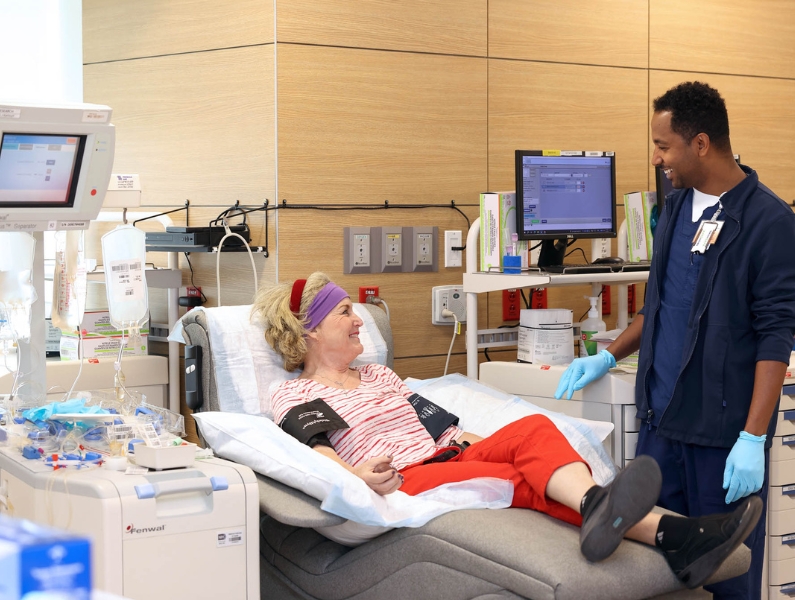
Sarah Fowler, a NIH Clinical Center Research Nurse Specialist, donates blood.
The Department of Transfusion Medicine (DTM) has completed its long-awaited move into the Clinical Center’s newly renovated E-Wing.
DTM sections occupy the first, second and third floors, with the Blood Bank donor center and Dowling Clinic apheresis clinic centrally located on the ground floor off the Magnuson Building central corridor.
Dr. Kamille West-Mitchel, chief of DTM’s Blood Services Section, said the clinics will now be more accessible and visible to Clinical Center patients, staff and visitors. West-Mitchell said she looks forward to seeing how blood donors respond to the new facilities, which are bright and modern and offer expanded capacity.
“Our blood donors are so valuable to everything that we do,” West-Mitchell said. “We really want to do as much as possible to make their experience a positive and rewarding one.” Other DTM sections will also move into state-of-the-art labs, production rooms and office space. The department’s old space had grown increasingly shopworn, cramped and, at times, eclipsed by the demands of new technology.
“It was built in the 1980s and really hadn’t been remodeled,” DTM Chief Dr. David Stroncek said.
The move into E-Wing enables many previously scattered lab and work groups to consolidate into a single, unified workplace worthy of today’s workforce.
“It should be more efficient for them to operate, and they can better meet the needs of the patients and investigators,” Stroncek said.
The Blood Bank donor center and Transfusion Services Lab will no longer share the same floor, however. Staff will use a small service elevator, or dumb waiter, to transfer blood products between floors.
Planning for the 250,000-square-foot E-wing renovation first began in 2015. The project became the most complex in NIH history. Largely completed last fall, it is now home to some 1,500 staff from 11 institutes and centers across NIH.
DTM and the Center for Cellular Engineering (CCE) are the last to take up residency, due in part to the exacting standards required of its clinical space, manufacturing labs and equipment.
“We kept finding little things that need to be fixed,” Stroncek said. “We’ve gotten a lot of help, and there [have been] a lot of people in the Clinical Center who worked really hard to make this happen.”
One highlight of the new facilities is the new 12th floor GMP (good manufacturing practices) manufacturing space for the CCE Cell Therapy Manufacturing Section, which will open later this year.
The GMP facility will be used to produce a range of cell therapies in aseptic production rooms, which are protected by special airlocks and other features to prevent contamination by viruses, bacteria and other microorganisms.
Stroncek said the space incorporates modular construction and panels that are easy to clean and tolerant of the intense cleaning required for GMP manufacturing spaces. “That is really a technical advancement,” he said.
David Weir is a consultant who was brought in to coordinate DTM’s complex move and ensure the continuous operation of vital services, such as the Blood Bank.
He said the collaboration across NIH to make the E-wing move successful has been extraordinary. “Moving is not easy. It can be emotional. It can be disruptive,” he said. “It’s taken a strong set of leaders and a strong team of employees to make this work.”
- Sean Markey
To schedule an NIH Blood Bank donation, visit: www.cc.nih.gov/blooddonor

